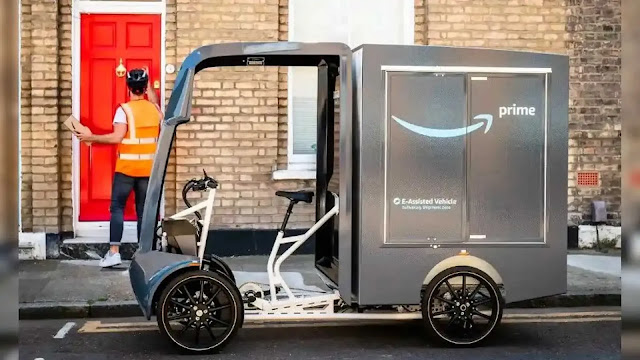Whenever you buy stuff on Amazon or other online retail platforms, did you ever stop to think of the intricate inner workings of how orders are placed, packed, shipped, and delivered to your doorstep? Unsurprisingly, shipping stuff around the globe consumes a lot, and I mean a lot of energy.
With today’s generation being more fixated on sustainability and reducing carbon emissions more than ever before, even the smallest changes to the way we consume energy can go a long way in helping us achieve our goals.This is exactly why Amazon is tackling things from a micro perspective, and has begun testing small electric cargo bikes in densely populated cities. These EVs are meant to replace the company’s aging fleet of delivery vans, which apart from producing emissions, take up a lot more space than the cargo electric bikes.
In a recent article by Electrek, Amazon’s efforts of testing cargo e-bikes in London were highlighted. In the article, Amazon UK’s Country Manager John Boumphrey stated: “Amazon is driving towards a global net-zero carbon future. One way we’re doing that is through the transformation of our transportation networks. Our new e-cargo bikes, walkers and growing electric vehicle delivery fleet will help us make more zero emission customer deliveries than ever before across London and the UK in the coming months.”
Wait, walkers? Yes, that’s right. Alongside the electric cargo bikes, Amazon is also employing delivery walkers to handle close-quarters deliveries in densely populated areas. With this setup, mobile package hubs, possibly powered by the previously mentioned electric cargo bikes, will supply delivery walkers with parcels to be delivered within the vicinity. This allows a much smoother workflow, with delivery personnel no longer needing to worry about things like parking, refueling, or recharging their vehicles.
As for the case of the electric cargo bikes, well, they aren’t bikes per se, as they’re equipped with four wheels. However, they do make use of an e-bike drivetrain and offer pedal assist functionality. Furthermore, an electric bike battery powers the system, and ultimately relies on the delivery rider’s pedaling input to propel the vehicle.
In a recent article by Electrek, Amazon’s efforts of testing cargo e-bikes in London were highlighted. In the article, Amazon UK’s Country Manager John Boumphrey stated: “Amazon is driving towards a global net-zero carbon future. One way we’re doing that is through the transformation of our transportation networks. Our new e-cargo bikes, walkers and growing electric vehicle delivery fleet will help us make more zero emission customer deliveries than ever before across London and the UK in the coming months.”
Wait, walkers? Yes, that’s right. Alongside the electric cargo bikes, Amazon is also employing delivery walkers to handle close-quarters deliveries in densely populated areas. With this setup, mobile package hubs, possibly powered by the previously mentioned electric cargo bikes, will supply delivery walkers with parcels to be delivered within the vicinity. This allows a much smoother workflow, with delivery personnel no longer needing to worry about things like parking, refueling, or recharging their vehicles.
As for the case of the electric cargo bikes, well, they aren’t bikes per se, as they’re equipped with four wheels. However, they do make use of an e-bike drivetrain and offer pedal assist functionality. Furthermore, an electric bike battery powers the system, and ultimately relies on the delivery rider’s pedaling input to propel the vehicle.
As it would turn out, Amazon isn’t the only company in the retail, courier, and delivery industry looking to make the green shift. UPS has also begun testing electric miniature delivery vans in Scotland and New York City. DHL is also testing similar EVs in the U.K. market. insideevs - link - Enrico Punsalang - link - more like this (last mile ev) - link - more like this (Amazon) - link

No comments:
Post a Comment